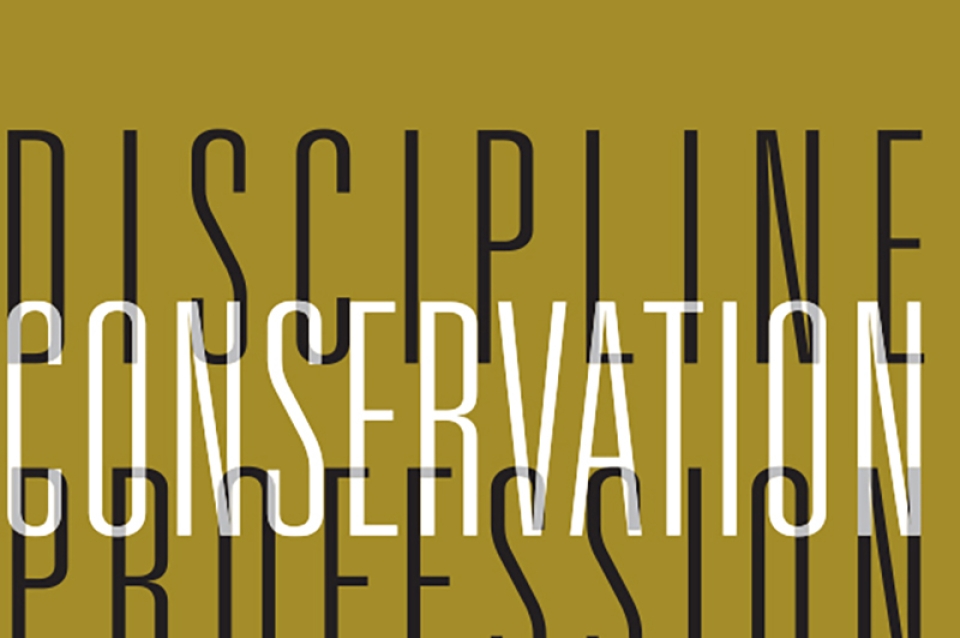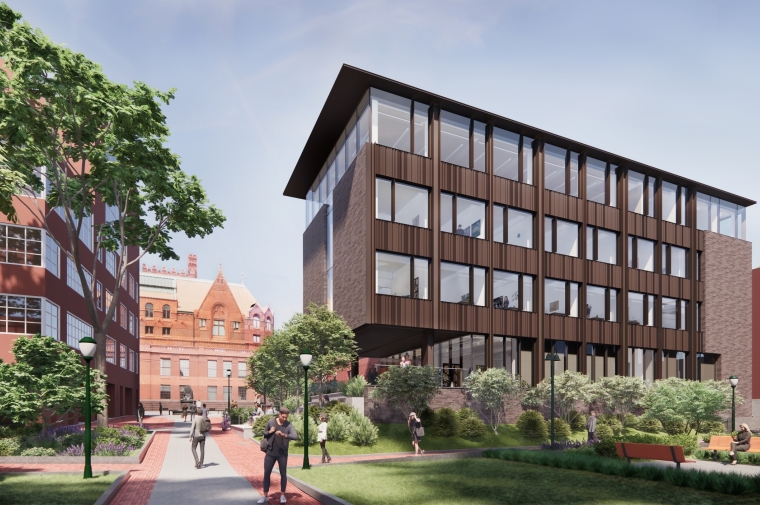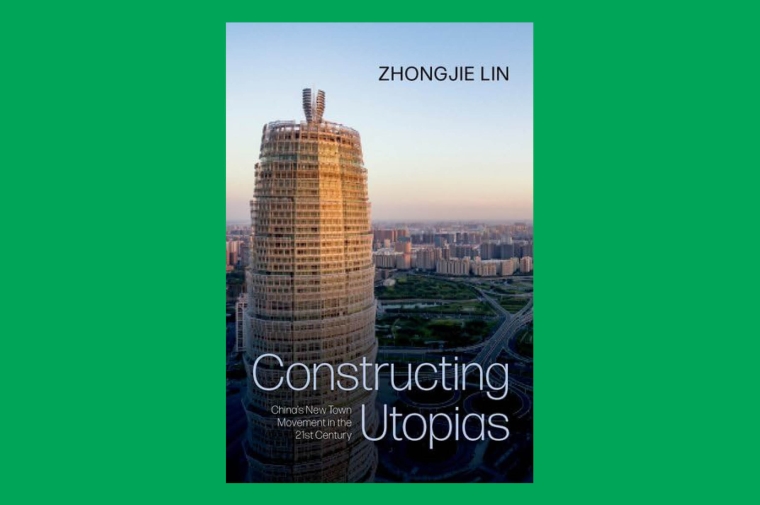December 2, 2021
Stuart Weitzman School of Design
102 Meyerson Hall
210 South 34th Street
Philadelphia, PA 19104
Get the latest Weitzman news in your Inbox
Change Over Time is a semiannual journal of the history, theory, and praxis of conservation and the built environment based at the Weitzman School and edited by Frank Matero, professor and chair of historic preservation, and Kecia L. Fong (MSHP‘99), managing editor and lecturer. The latest issue, 10.1 Conservation – Discipline & Profession, examines the ways that modern conservation has matured into a discreet field of intellectual inquiry and an interdisciplinary professional practice. Articles in the issue include a look at the evolving role of conservation in contemporary India, as well as an argument for equity preservation. In an introductory essay entitled "Historic Preservation: An American Perspective on a Professional Discipline," Matero surveys the practice of historic preservation since it was first taught at American universities and the state of the field today. The full issue, as well as the archives of past issues, can be accessed through Project Muse.
Beginning in the mid-1960s, courses in “historic preservation” entered a number of American universities, later developing into discrete academic programs by the 1970s.(1) These programs, many housed in schools of architecture and planning, emerged in reaction to prevailing design education and practice, gaining support from a public tired of the largely banal and placeless buildings and urban environments that postwar architects and planners had created, often at the expense of vital urban neighborhoods and popular civic monuments such as Pennsylvania Station in New York City. By the early 1970s, the nation’s approaching bicentennial only fueled the desire to take stock of the country’s entire built legacy, rather than a select white colonial past as celebrated one hundred years earlier. As part of a larger academic movement in interdisciplinary studies and the rise of public interest and activism in environmental issues, policy, and legislation in the 1980s, historic preservation programs multiplied and thrived.
Any discussion of the development of historic preservation as an academic discipline and professional practice must recognize the existing complexities of definition and authority debated in architecture, planning, and landscape architecture, as well as a growing number of challenges from upstart fields including urban design. Dagenhart and Sawicki have described the relationship between architecture and planning as dynamic and diverging, with each discipline defining itself through contrasting paradigms of research-based or practice-based education, the engagement of physical versus social space, and an orientation in policy and process versus representation and production.(2) The fact that historic preservation entered the academy, and specifically schools of design, in this context, acknowledges the recognition that what was largely perceived as a popular movement, found legitimacy in the academy, where students could be educated, professional values formed, and knowledge and creative work produced and disseminated. Despite this new influence, architecture and planning curricula remained focused on the new, and anything else was suspect. Even an obvious ally such as architectural history experienced shifting “alliances and estrangement” with historic preservation as both fields evolved over time, each exploiting and influencing the other, while design programs and professionals watched from the sidelines.(3)
What began as a reactionary, cross-disciplinary field of study has continued to evolve, as the phenomenon of heritage has now been claimed by a number of established disciplines outside architecture and planning, and the field has achieved research status through a limited number of PhD programs. While a critical history of historic preservation as discipline and practice has yet to be written, no one can doubt the effect of one on the other since the first graduate class emerged more than fifty years ago.(4) With issues of public memory; place making; and social, environmental, and cultural equity now demanding greater attention in planning and design programs, historic preservation has found broader acceptance within the academy and in the profession.
James Marston Fitch, founder of the first graduate program in historic preservation at Columbia University in 1964, initially as a two-semester course and later as a distinct master of science program in 1973, broke established disciplinary boundaries by creating a curriculum that was hybrid in theory and method and open to anyone with a relevant background other than design (e.g., history, physical, earth and social sciences).(5) Already a well-known author on diverse architectural subjects, a critic, and a public intellectual when he introduced preservation courses at Columbia, Fitch viewed historic preservation as an antidote to what ailed contemporary architecture and planning as then taught at the academy. In constructing preservation’s history, he frequently cites amateurism in his lectures and writing as a key to its early success and, through his own efforts, a challenge to the dominant academic and professional attitudes toward the historical built environment.(6) His vision of a new discipline and profession was based on a “synoptic” or cross-disciplinary approach that aimed to correct the myopic focus of specialization and certified expertise that he felt characterized and limited the design and planning professions. The creation of a new discipline and profession free from the bind and power of established doctrine and informed by activism is later echoed by Edward Said, who challenges academics to embrace knowledge, practice, and activism combined to define the new professional intellectual as “someone who considers that to be a thinking and concerned member of society one is entitled to raise moral issues at the heart of even the most technical and professionalized activity.”(7) A half century later, historic preservation is now asking the same questions every evolving profession has asked before.
A Discipline and Profession
“Discipline” and “profession” are often incorrectly used interchangeably. Prevailing notions of what constitutes an academic discipline are based on the organization of knowledge in accordance with norms that clearly define the subject matter and the procedures or methods by which new knowledge is generated. Traditional academic subjects such as the biological or physical sciences, history, or philosophy have long been considered academic disciplines and directly associated with university departments, the result of several centuries of development from medieval academies to the modern university. By contrast, subjects and departments organized around the application of basic knowledge to solve practical problems, generally to serve the public good, such as social work, law, medicine, and engineering, are commonly relegated to professional schools. In any discipline, members systematically collect facts and study both the nature of the questions asked as well as the answers generated. From this, a clearer understanding and correlation between the questions posited and the facts generated eventually become established. This leads to shared methodologies conditioned by philosophical and intellectual concerns, which in the case of professional disciplines, define and guide practice. Theory and practice must therefore move together, each informing the other in framing approaches and solutions and, most importantly, periodically reevaluating the validity and usefulness of both.
Architecture and planning derive from a broad interdisciplinary knowledge base, and their application to problem solving (like the social sciences to social work or physics to electrical engineering), generally with social implications, define them as bona fide professions. Formally not as old as medicine or law, they nevertheless employ methods of analysis and synthesis we call “design” unique to them alone. While the distinction between academic and professional subjects seems clear enough, any current debate as to whether professional fields should be considered true “disciplines” seems pointless and out of date.(8)
More than fifty years ago, American sociologist Bernard Barber identified four attributes that define a profession: a high degree of generalized and systematic knowledge, a primary orientation to community interest rather than personal interest, a high degree of self-control of behavior through a code of ethics, and a system of monetary and honorary rewards that symbolize achievements of the work itself.(9) In summarizing the professions in America in the early twenty-first century, Gardner and Shulman further identify all professions as defined by six “commonplace characteristics”: a commitment to serve society responsibly, selflessly, and wisely; a body of theory or special knowledge that is best obtained through an academic education; the utilization of a specialized set of skills, practices, and performances; the capacity to render judgments with integrity under conditions of both technical and ethical uncertainty (i.e., critical thinking); the involvement of an organized approach to learning from experience both individually and collectively and, thus, of growing new knowledge from the contexts of practice; and representation by a professional community responsible for the oversight and monitoring of quality in both practice and professional education.(10) In this regard, historic preservation possesses most of the characteristics of a profession. Yet while all agree that explicit training regimes, formal licensure, and procedures designed to distinguish the generalist from the specialized define the professions today, historic preservation still does not enjoy educational accreditation or formal licensure.
A Way Forward
Today, historic preservation is considered an intellectual discipline that is built on a body of knowledge, skills, and experience, as well as the ability to analyze and solve complex problems. Although many of these methods are borrowed from other disciplines, their application to preserve and safeguard heritage is unique to it alone. Like all professional disciplines, preservation has been shaped by its historical habits and by contemporary concerns. It has continued to evolve, moving from its initial divergence from architecture and planning in the 1970s to convergence as designers and planners began to pay more attention to environmental and cultural heritage and preservation’s nascent concerns for human rights and social equity in the 1980s.(11)
As for all established professions, codes of ethics, and by extension, licensing laws, define and control what a profession “professes.” If by ethics we mean the moral principles or rules of conduct by which a person is guided, then when applied collectively to members of a profession, ethics define the duties and responsibilities each member has to the public, to one another, and to themselves in regard to the exercise of their profession. Such principles help define notions of right and wrong, and actions appropriate and inappropriate, based in part on defined parameters and criteria established within and by the profession. These principles in turn are often applied in the creation of policy and courses or plans of action. Ethics and ethical practice have long been associated with heritage preservation and conservation, given its focus on protecting and safeguarding the significant and the irreplaceable. Implicit in the word and concept, “heritage” is the notion of legacy, thus conveying and establishing a moral imperative in the treatment and protection of this collective human inheritance. Ethical standards were first developed to define and guide conservation practice in the United States in the 1960s with the publication of the American Institute of Conservation’s Code of Ethics and later, for built heritage, the Secretary of the Interior’s Standards and Guidelines for Rehabilitation in the 1970s.(12)
After nearly half a century of formal practice, institutional representation, the creation of national and international organizations and journals, and the development of academic training programs, a professional maturation as well as a crisis of identity for the field appears to be on the horizon. The inherent interdisciplinary and inclusive concerns of historic preservation range from diversifying historical narratives and advocating for social cohesion and equity to the physical curation of structures, sites, and places of cultural and historical significance. This diversity of interest and method raises challenging questions of disciplinary and professional boundaries and calls upon the profession to articulate its authority upon itself and among existing professions and the public. Without the ability to define and secure its “domain of practice” through educational accreditation and professional licensure, historic preservation may well lose the gains it has made in contributing to the dramatic shift in attitudes toward the design and embrace of the existing built environment and the rise of sustainability and place making in that encounter.
The contributions in this issue clearly reflect new approaches to long-standing concerns about the uses and abuses of preservation. Similar to the social and political upheaval of the 1960s, current outrage over and debate on social and environmental equity, human rights, diversity of expression, and inclusion all require the field and its practitioners to reexamine disciplinary curricula and professional practice to continue the legacy of the field as a catalyst for positive change.
(1) Michael Tomlan, “Historic Preservation Education: Alongside Architecture in Academia,” Journal of Architectural Education 47, no. 4 (May 1994): 187.
(2) Richard Dagenhart and David Sawicki, “Architecture and Planning: The Divergence of Two Fields,” Journal of Planning Education and Research 12 (1992): 5.
(3) Daniel Bluestone, “Academics in Tennis Shoes,” Journal of the Society of Architectural Historians 58 (1999): 300.
(4) Efforts toward a critical national history of historic preservation in the United States have not been attempted since Charles Hosmer’s two-volume chronicle: Charles B. Hosmer, Presence of the Past: A History of the Preservation Movement in the United States before Williamsburg (New York: Putnam, 1965); and Preservation Comes of Age: From Williamsburg to the National Trust, 1926–1949 (Charlottesville: Published for the Preservation Press, National Trust for Historic Preservation in the United States by the University Press of Virginia, 1981). For a more recent general account, see William J. Murtagh, Keeping Time: The History and Theory of Preservation in America (Hoboken, NJ: Wiley, 2006); and for specific regional histories, Randall Mason and Max Page, eds., Giving Preservation a History: Histories of Historic Preservation in the United States (New York: Routledge, 2020).
(5) Tomlan, “Historic Preservation Education,” 189.
(6) Fitch first introduced the idea of the amateur with respect to the professionalization of architecture and later applied it to historic preservation. See James Marston Fitch, “The Profession of Architecture,” in The Professions in America, ed. Kenneth Schuyler Lynn (Boston: Houghton Mifflin, 1965), 231–41.
(7) Edward Said, “Professionals and Amateurs,” in Representations of the Intellectual (New York: Vintage Books, 1996), 73–83.
(8) For an interesting debate on the disciplinary justification for architecture and planning, see Robert Dyke’s commentary following Dagenhart and Sawicki’s paper and their response: Journal of Planning Education and Research 12 (1992): 143–48.
(9) Howard Gardner and Lee S. Shulman, “The Professions in America Today: Crucial but Fragile,” Daedalus 134, no. 3 (2005): 14.
(10) Ibid., 14–16.
(11) Bonnie J. Johnson and Nils Gore, “What Do the Professions ‘Profess’? Comparing Architecture and Planning Codes of Ethics,” Architectural Science Review 59, no. 6 (2016): 461.
(12) American Institute for Conservation (AIC) and Foundation for Advancement in Conservation (FAIC), Our Code of Ethics, accessed November 9, 2020, https://www.culturalheritage.org/about-conservation/code-of-ethics; National Park Service, Secretary’s Standards for Rehabilitation, accessed November 9, 2020, https://www.nps.gov/tps/standards/rehabilitation.htm.


 Expand Image
Expand Image


